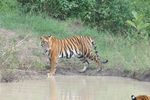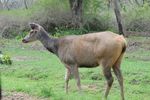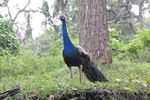Bandipur Field Trip - 8th to 10th October, 2020
←
→
Page content transcription
If your browser does not render page correctly, please read the page content below
Bandipur Field Trip - 8th to 10th October, 2020
As a part of the International Conference on Mammoths and their Relatives, at the Indian Institute
of Sciences, Bangalore, 1st to 10th October 2020
Introduction the Bandipur and the wider region
Bandipur is one of the largest nature reserves in South India, at the centre of network of forests that are
home to the largest population of Asian elephant and tigers in the world.
The park is a little over 900 km2, at the southern edge of the state of Karnataka. It adjoins the
Mudumalai Tiger Reserve to the south, the Sathyamangalam Tiger Reserve to the east, and Wayanad
and Nagarhole to the west/north. Together, this forms the core of the Nilgiri Biosphere Reserve (NBR),
the first biosphere reserve declared in India under the UNESCO Man and Biosphere programme. Itcovers an area of 5500 km2, spread across three south Indian states. This network of forests includes altitudes varying from 250m to 2650m, and rainfall from 600mm to 4600mm. This range of topography and climate has resulted in sharp gradients of vegetation and very high biodiversity, and is central to the Western Ghats- Srilanka, the 8th “hottest” Biodiversity global biodiversity hotspot. The mountain range was formed when the Indian sub continent broke away from the Gondwana landmass about 150M years ago, an harbour the majority of India’s biodiversity. It is perhaps one of the only regions in the world, where species like the Blackbuck from semi arid habitats, the Nilgiri Tahr in the high altitudes of the Nilgiri hills, and the Lion-tailed macaque of the rainforests of Kerala, existing almost alongside each other. The region is also highly populated – with c. 2 million people living in it spread across 30 different communities with varying ethnicities and modes of subsistence, and is arguably one of the most anthropologically studied regions in the world. Bandipur and the wider connected forests spread over 12,000 sq. km are home to about 8000 Asian elephants and over 500 tigers, which are now one of the largest populations of these in India and globally. While there is significant conservation focus around these large and charismatic animals, Bandipur is also home to a range of other less well known yet equally important species. Some of the major mammals include: leopard, sloth bear, wild dog (dhole), jackal, giant and flying squirrel, mongoose, sambar, spotted, barking and mouse deer, gaur, wildboar, blackbuck and also the very elusive four horned antelope. There are also a wide diversity of birds, reptiles, amphibians and plants, with a more comprehensive list available on the park website (https://bandipurtigerreserve.in/web/wp- content/uploads/2013/10/Biodiversity.pdf). Historically, like many of the other parks in India, Bandipur was the hunting grounds of the erstwhile Royal family, who controlled much of South India from around 1400 CE. Bandipur formed the southern boundary of the territory they controlled, and was first declared the “Venugopala Wildlife Park” under the Mysore Game and Forest Preservation and Regulation Act in 1931, with an area of about 90 km2. From there it was expanded to about 800 km2 in 1942. Bandipur was one of the first nine tiger reserves declared in India in 1974, and got its name from the village of Bandipur that became its headquarters. Today it remains one of the best ranked and managed tiger reserves by the National Tiger Conservation Authority.
Other areas of Interest
Bandipur is about 230 km south of Bangalore, and a 5-hour drive, which also passes through the
historic city of Mysore. In addition to the wildlife safaris in Bandipur, visits to some other locations en-
route/nearby may also be possible, some of which are:
The town of Ramnagara; well known in geological circles for the exposed late Archaean rock
formations (2500 M years old), and also for its silk production, with the town hosting one of the
largest silk cocoon markets in Asia (https://en.wikipedia.org/wiki/Ramanagara)
The craft town of Channapatna, known for the brightly coloured toys, traditionally made from
wood of the Wrightia tinctoria, and lacquered (vegetable/natural dyes infused into the sap of
Toxicodendron vernicifluum or related trees (https://en.wikipedia.org/wiki/Channapatna_toys),
which also hosts Janapadaloka, a local folklore museum
(https://en.wikipedia.org/wiki/Janapada_Loka)
Srirangapatna and Tippu Sultan’s summer palace – an island town enclosed by the Kaveri river,
which was the capital of the Mughal rulers Hyder Ali and his son Tippu Sultan, the last of the
Indian kings to resist colonial rule. He was killed while defending his fort in 1799, during the 4th
Anglo-Mysore war (https://en.wikipedia.org/wiki/Tipu_Sultan)
The Somnathpur temple, built in 1258CE, which highlights the development in the Hoysala
Dynasty and a classic illustration of the intricate Hoysala architecture (https://en.wikipedia.org/
wiki/Chennakesava_Temple,_Somanathapura)
The natural history museum in Mysore, which houses a small part of the Van Ingen Collection,
one of the best known taxidermists in the world, operating between 1900-1999, processing over
43 thousand specimens from around the world (https://en.wikipedia.org/wiki/Van_Ingen_
%26_Van_Ingen)
The elephant camp in Mudumalai, which is home to about 30 captive elephants used in
activities such as patrolling, anti-poaching and minimising human-elephant conflict, managed
primarily by mahouts from the Bettakurumba tribe.
A workshop in Thorapalli, where indigenous communities are using Lantana camara (an
invasive weed) to making life sized elephant sculptures that are travelling around the world in
public exhibitions aimed at fostering better human-elephant CoExistence.
While visiting all these sites will not of course be possible, the trip will include at least two stops, with
the possibility of short visits in smaller groups if people are particularly interested.Tentative field trip itinerary Day 1: Thursday, 8th October, 2020: 0700: Depart from Bangalore by bus, and drive south towards Mysore. 1000: Arrive at Tippu Sultan’s Summer Palace in Srirangapatnam for a tea break, and a brief guided tour of the palace and Tippu’s legacy. 1100: Drive on, further south to Bandipur. 1330: Arrive at Bandipur accommodation, have lunch, check in to rooms, with short time for rest. 1500: Leave for afternoon Safari drive into the Bandipur Tiger Reserve. 1800: Return to accommodation for dinner. Day Friday, 2: 9th October 2020: 0700: Leave for early morning Safari drive. 1000: Return to accommodation for breakfast and rest. 1500: Afternoon Safari drive. 1800: Return to accommodation for dinner. Potential Alternative: Skip either morning or afternoon safari, and visit the Elephant Camp at Mudumalai and/or the Lantana Elephant Unit in Thorapalli. Day 3: Saturday, 10th October 2020: 0700: Short Safari drive or a short bird watching walk, followed by breakfast. 0830: Depart from Bandipur Accommodation towards Mysore. 1000: Arrive at the Mysore Natural History Museum, for a brief tour of the Museum. 1130: Depart from Mysore, towards Bangalore. [Alternative: Visit the exquisite Somnathpur Temple] 1330: Stop for a traditional “Kannadiga” meal, followed by a visit Janapada Loka, the folklore museum. 1530: Carry on towards Bangalore. 1800: Arrive at Bangalore and transfer to the airport for flights departing 20:00 or later Potential Alternative: For those wishing to leave earlier, a separate taxi can be arranged (at extra cost) to leave Bandipur early morning, and arrive in Bangalore airport by 1200 hrs.
Illustration 1: Tiger(s!) at a waterhole Illustration 2: Young male elephant Illustration 3: Female led herd of elephants Illustration 4: Indian Gaur
Illustration 5: Peacock Illustration 6: Sambar deer Illustration 7: Chital Illustration 8: Dolmen in Bandipur
You can also read


























































